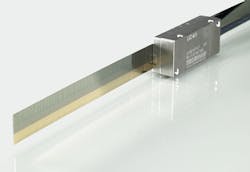Linear Encoders and Direct Drive Linear Motors
Linear motors have become commonplace in manufacturing and measuring equipment used in the semiconductor industry, in PCB (printed circuit board) assembly machines, medical device manufacturing, textile machines and other automation applications requiring highly precise movement. But linear motors on their own are not the single most important ingredient in these dynamic industrial applications. Direct drives for open and closed-loop control require continuous real-time and exact information on the position of the slide. The accuracy, performance and reliability of the individual axes depend on the linear measuring devices used. In connection with linear motors, compact, contact-free measuring devices called exposed linear encoders are increasingly used to perform these high-precision tasks.End-users and machine designers tend to agree that the advantage of direct drive technology is the stiff coupling of the drive to the feed component without any other mechanical transfer elements. This allows significantly higher gain in the control loop than with a conventional drive. And it is here that the efficiency of a linear motor is greatly influenced by the selection of the position encoder. High control-loop gain can only be achieved if the encoder provides high-quality position signals. With the high gain required in the control loops, even minor disturbances in the encoder output signal can cause serious trouble in drive performance. The higher quality of the position information noticeably improves velocity control and positioning. In addition, the motor operates quietly and develops only a small amount of heat.Velocity measurement on direct drivesOn direct drives, there is no additional encoder for measuring the speed. Both position and speed are measured by the position encoder, with linear encoders used for linear motors and angle encoders for rotating motors. Since there is no mechanical transmission between the speed encoder and the feed unit, the position encoder must have a correspondingly high resolution in order to enable exact velocity control, particularly at slow traversing speeds. Velocity is calculated from the distance traversed per unit of time. This method—which is also applied to conventional axes—represents a numerical differentiation that amplifies periodic disturbances or noise in the signal. The significantly higher control loop gain on direct drives dramatically increases the influence of the signal quality on drive performance.Linear encoders that generate a high-quality position signal with only small interpolation error are therefore essential for the meaningful operation of direct drives. Encoders that use photoelectric scanning are particularly suitable for this type of application since very fine graduations can be used as measuring standards by this method. These encoders provide benefits in the positioning, speed stability and thermal behavior of a direct drive. Until recently, an absolute position value calculation and the associated availability of the position value immediately after encoder switch-on without any axis movement were not available with exposed linear encoders. Though this information could be accessed with sealed absolute linear encoders, such encoders are not commonly used on direct drives because of their larger size. Exposed encoders, thanks to their lack of an enclosure, have very small dimensions and low weight and are better suited for direct drive applications. However, they were previously available only in incremental versions. To address this issue, Heidenhain developed the LIC 4000 exposed linear encoder – an absolute and exposed linear encoder with EnDat 2.2 serial interface.Heidenhain encoders with optical scanning incorporate measuring standards of periodic structures known as graduations. This feature is considered a fundamental prerequisite for low interpolation error, and therefore for smooth operating performance and high control loop gain. In the LIC 4000 series, with its absolute graduation, the position value is available from the encoder upon machine switch-on. The absolute position information is scanned from the scale graduation, which is configured as a pseudo-random-coded track (PRC) and a separate incremental track. The position information is ascertained through the evaluation of the PRC track and the incremental track. The newly developed scanning method used in the LIC 4000 series is based on the high quality of the graduation and provides absolute position values with a specified interpolation error of less than ± 40 nm. Despite its exposed design, the LIC 4000 is tolerant of contamination (due to its production employing the Metallur process). Everyday contamination resulting from small quantities of oil, dust, fingerprints, hair or small metal objects were tested in a laboratory and showed few effects on operational reliability.The scanning signals of the LIC 4000 series are digitized in the scanning head and converted into a high-resolution position value. This eliminates the transmission of analog signals from the scanning head for drive control. High control loop gain enabled by the LIC 4000 is due to the encoder’s use of the high clock frequency of the EnDat interface and the resulting short read-out times. EnDat 2.2 is considered the fastest purely serial interface for position encoders based on the RS485 transmission characteristics (Source: www.endat.de).By Kevin Kaufenberg, Product Manager, Heidenhain Corp.

